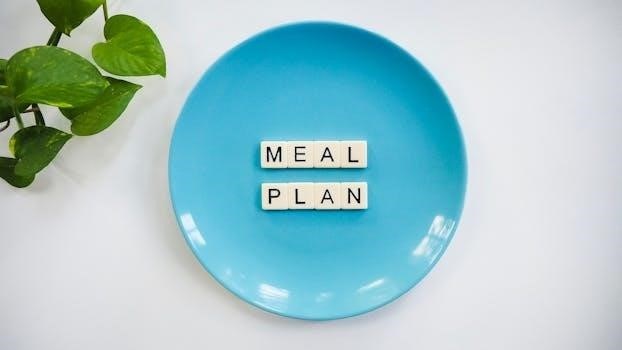Metabolic Confusion Meal Plan⁚ A Comprehensive Guide
Embark on a journey to understand the metabolic confusion diet‚ a strategy to boost your metabolism and avoid weight-loss plateaus. Discover how calorie cycling works‚ explore sample meal plans‚ and learn how to design your own plan.
What is the Metabolic Confusion Diet?
The metabolic confusion diet‚ also known as calorie cycling‚ is an eating pattern that involves alternating between high-calorie and low-calorie days. This strategy aims to “confuse” the metabolism‚ preventing it from adapting to a consistently low-calorie intake‚ which can lead to weight-loss plateaus. The idea is similar to intermittent fasting but offers more flexibility in meal planning.
By varying calorie intake‚ the body is encouraged to burn fat more efficiently. Some people find it helpful to use meal plan apps or calorie trackers to monitor their progress and ensure they are staying within their target calorie ranges. For example‚ one day you may consume around 2000 calories‚ and the next day you might aim for 1000 to 1200 calories. It’s essential to consult with a healthcare professional before starting any new diet‚ especially one that involves significant caloric changes. This approach can be tailored to individual needs and preferences for a sustainable lifestyle.
The Science Behind Metabolic Confusion and Metabolism Boosting
The science behind metabolic confusion centers on the body’s adaptive response to consistent calorie restriction. When the body consistently receives fewer calories‚ it can slow down metabolism to conserve energy‚ hindering weight loss. Metabolic confusion aims to prevent this adaptation by introducing variability in calorie intake.
When you consume calories‚ the body converts them into glucose‚ which serves as energy. By alternating between high and low-calorie days‚ the body is less likely to enter a state of metabolic slowdown. This variation can help maintain a higher metabolic rate‚ promoting more efficient fat burning.
Integrating carb cycling can further enhance this effect. By varying carbohydrate intake along with calories‚ you can influence insulin sensitivity and glycogen stores‚ optimizing energy utilization. Lean meats‚ eggs‚ and dairy products support metabolism.
Crafting a metabolic confusion meal plan strategically manipulates dietary factors.
Benefits of Metabolic Confusion for Weight Loss
Metabolic confusion offers several potential benefits for weight loss‚ primarily by preventing the body from adapting to a consistent calorie deficit. This variability can help maintain a higher metabolic rate‚ leading to more efficient fat burning and sustained weight loss. By alternating between high and low-calorie days‚ the body is less likely to enter “starvation mode‚” where it conserves energy and slows down metabolism.
The flexible nature of metabolic confusion can also make it easier to adhere to compared to strict‚ long-term calorie restriction. This flexibility can reduce feelings of deprivation and make the diet more sustainable over time. The inclusion of higher-calorie days can also provide psychological relief‚ making the overall dieting process more manageable.
Moreover‚ metabolic confusion can improve insulin sensitivity and carbohydrate utilization. This approach also promotes a healthy‚ sustainable lifestyle.
Designing Your Own Metabolic Confusion Meal Plan
Creating your metabolic confusion meal plan involves strategic planning to alternate between high and low-calorie days. First‚ determine your maintenance calorie level—the number of calories you need to maintain your current weight. Then‚ establish your high-calorie day target‚ typically at or slightly above maintenance‚ and your low-calorie day target‚ usually 500-1000 calories below maintenance.
Consider your activity level and adjust calorie targets accordingly. Plan your meals around whole‚ unprocessed foods‚ incorporating lean proteins‚ healthy fats‚ and complex carbohydrates. Structure your week with a mix of high and low-calorie days; a common approach is alternating days or two high-calorie days followed by one or two low-calorie days.
Track your progress using a meal plan app or calorie tracker to monitor your intake and make adjustments as needed. Remember‚ consistency and flexibility are key to success. Always consult with a healthcare professional before starting any new diet.
Sample 7-Day Metabolic Confusion Meal Plan (Example)
Here’s a sample 7-day metabolic confusion meal plan for someone needing 2150 calories for maintenance‚ aiming to lose about one pound per week. Always consult a healthcare professional before starting any new diet.
Day 1 (High-Calorie)⁚ Breakfast⁚ Greek yogurt with berries and honey. Lunch⁚ Grilled chicken sandwich on whole-grain bread with avocado. Dinner⁚ Baked salmon with quinoa and roasted vegetables. Snacks⁚ Almonds and a banana.
Day 2 (Low-Calorie)⁚ Breakfast⁚ Scrambled eggs with spinach. Lunch⁚ Salad with grilled shrimp. Dinner⁚ Vegetable soup. Snacks⁚ Apple slices.
Day 3 (High-Calorie)⁚ Breakfast⁚ Oatmeal with nuts and seeds. Lunch⁚ Leftover baked salmon and quinoa. Dinner⁚ Turkey breast with steamed veggies and brown rice. Snacks⁚ Protein shake.
Day 4 (Low-Calorie)⁚ Breakfast⁚ Cottage cheese with berries. Lunch⁚ Tuna salad on lettuce wraps. Dinner⁚ Chicken stir-fry with lots of vegetables. Snacks⁚ Celery sticks with hummus.
The plan continues similarly for days 5-7‚ alternating high and low-calorie intakes.
High-Calorie Day Meal Ideas
High-calorie days are crucial for preventing metabolic slowdown during a metabolic confusion meal plan. These days allow you to enjoy larger portions and incorporate nutrient-dense foods to fuel your body.
Breakfast⁚ Opt for oatmeal with mixed berries‚ nuts‚ and a drizzle of honey. Alternatively‚ try whole-grain toast topped with mashed avocado and poached eggs. Greek yogurt with granola and fruit is another great option.

Lunch⁚ A grilled chicken sandwich on whole-grain bread with avocado provides a good balance of protein and healthy fats. Consider leftovers from dinner‚ such as baked salmon with quinoa.
Dinner⁚ Baked salmon with roasted vegetables and quinoa is a classic high-calorie meal. Turkey breast with steamed veggies and brown rice is another excellent choice.
Snacks⁚ Almonds‚ bananas‚ protein shakes‚ and trail mix are convenient high-calorie snack options.

Remember to prioritize whole‚ unprocessed foods to maximize nutrient intake and support your metabolism on high-calorie days.
Low-Calorie Day Meal Ideas
Low-calorie days are designed to create a calorie deficit‚ promoting weight loss within the metabolic confusion plan. These days require careful meal planning to ensure adequate nutrient intake while keeping calories low.
Breakfast⁚ Scrambled eggs with spinach offer a protein-packed start to the day with minimal calories. A small serving of Greek yogurt with a few berries is another light option.
Lunch⁚ A large salad with grilled chicken or fish provides a filling yet low-calorie meal. Vegetable soup with a side of whole-wheat crackers is a comforting and healthy choice.
Dinner⁚ Baked cod with steamed asparagus is a lean and nutritious option. A stir-fry with plenty of vegetables and a small portion of tofu or shrimp is also suitable.

Snacks⁚ Celery sticks with hummus‚ a small apple‚ or a handful of almonds can help curb hunger between meals.
Hydration is key on low-calorie days‚ so drink plenty of water and herbal tea.
Incorporating Carb Cycling into Your Metabolic Confusion Plan
Carb cycling can be a powerful addition to a metabolic confusion meal plan‚ adding another layer of manipulation to your metabolism. This involves alternating between high-carb and low-carb days‚ often aligning with your high and low-calorie days.
On high-calorie days‚ incorporate complex carbohydrates like oatmeal‚ quinoa‚ brown rice‚ and sweet potatoes. These provide energy for workouts and help replenish glycogen stores.
Low-carb days should focus on lean proteins‚ healthy fats‚ and non-starchy vegetables. This helps promote fat burning and maintain stable blood sugar levels.
Consider structuring your week with a few high-carb days‚ moderate-carb days‚ and low-carb days. For example‚ you might have two high-carb days coinciding with intense workout days‚ two low-carb days to encourage fat loss‚ and three moderate-carb days to maintain balance.
Monitor your body’s response and adjust carbohydrate intake based on your energy levels‚ performance‚ and weight loss goals.
Foods to Include in Your Metabolic Confusion Meal Plan
A successful metabolic confusion meal plan relies on incorporating a variety of nutrient-dense foods to support both high and low-calorie days. Lean proteins are crucial‚ including chicken breast‚ turkey‚ fish (salmon‚ tuna)‚ eggs‚ and Greek yogurt. These help maintain muscle mass and promote satiety.
Healthy fats are also essential‚ such as avocados‚ nuts‚ seeds‚ olive oil‚ and fatty fish. They provide energy‚ support hormone production‚ and improve nutrient absorption.
Complex carbohydrates should be prioritized on high-calorie days‚ including oatmeal‚ quinoa‚ brown rice‚ sweet potatoes‚ and whole-grain bread. These provide sustained energy and fiber.
Non-starchy vegetables are important for both high and low-calorie days‚ including leafy greens‚ broccoli‚ cauliflower‚ bell peppers‚ and zucchini. They are low in calories and high in vitamins‚ minerals‚ and fiber.
Fruits can be included in moderation‚ especially berries‚ apples‚ and citrus fruits. They provide antioxidants and vitamins.
Important Considerations and Precautions
Before starting a metabolic confusion meal plan‚ it’s essential to consult with a healthcare professional‚ especially if you have underlying health conditions like diabetes‚ heart disease‚ or kidney issues. This diet involves significant changes in caloric intake‚ which may not be suitable for everyone.
Proper hydration is crucial. Drink plenty of water throughout the day to support metabolic processes and prevent dehydration‚ especially on high-calorie days.
Listen to your body and adjust the plan accordingly. If you experience excessive fatigue‚ dizziness‚ or other adverse effects‚ reduce the calorie deficit or consult with a healthcare provider.
Avoid processed foods‚ sugary drinks‚ and excessive amounts of caffeine and alcohol‚ as these can hinder weight loss and negatively impact your health.
Ensure you are meeting your micronutrient needs by consuming a variety of nutrient-dense foods. Consider taking a multivitamin if necessary‚ but always consult with a healthcare professional first.
This plan is not intended for long-term use without professional guidance.

Finding Free PDF Resources and Meal Plan Examples
Discovering free PDF resources and meal plan examples for metabolic confusion is easier than you think. Start by searching online using specific keywords such as “metabolic confusion meal plan PDF” or “calorie cycling diet plan examples.” Many websites‚ blogs‚ and forums dedicated to health and fitness offer downloadable meal plans and guides.
Look for reputable sources‚ such as registered dietitians or certified nutritionists‚ to ensure the information is accurate and safe. University extension programs and government health websites may also provide reliable resources.
Be cautious of websites that promise unrealistic results or promote unproven methods. Always cross-reference information and consult with a healthcare professional before making any significant dietary changes.
Explore online communities and social media groups focused on weight loss and healthy eating. Members often share their meal plans‚ recipes‚ and experiences with metabolic confusion.
Remember to adapt any meal plan to your individual needs and preferences. A generic plan may not be suitable for everyone‚ so customize it to fit your calorie requirements‚ dietary restrictions‚ and taste preferences.

No Responses